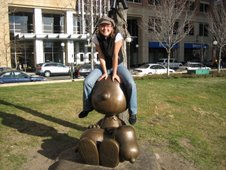Nairobi is an enormous and busy city with people anytime and everywhere. At least thats was my first impression as a person coming from Wien :-) Walking on the main Moi avenue is like searching for free space on the payment where one would not hit other pedestrians. Locals have a perfect talent in doing so. Seeing that you are white (“mzungu” in kiswahili), they usually give you little more space. I was delighted meeting thousands of people on these busy streets. I met more people during the first two days than I usually meet during one week in Wien and got really excited. My head got overwhelmed after 2 days of this excitement, though. Then I learnt how to “filter” - random selection of people on the street.

 Tip for travelers: I like walking, that’s my ordinary way of exploring new cities. Walking in Kenya can get rather tiring and uncomfortable, though. Locally, you have to walk through gravel mixed with water, pavement is missing and matatu may pass only 40 cm from you with rather high speed. The dusty environment may then help to finalize your wrong impression of Nairobi - “dirty and unfriendly city”.
Tip for travelers: I like walking, that’s my ordinary way of exploring new cities. Walking in Kenya can get rather tiring and uncomfortable, though. Locally, you have to walk through gravel mixed with water, pavement is missing and matatu may pass only 40 cm from you with rather high speed. The dusty environment may then help to finalize your wrong impression of Nairobi - “dirty and unfriendly city”.
I would highly advice to take it easy at the beginning, walk only short distances, use buses, don’t try to reach more then 2-3 attractions a day (traffic jams are unexpectable) and try to find time to stop once in the while and look around, follow the flow of people and cars coming and heading to …somewhere, stop in the store and spend some time talking with locals, you may learn a lot, but.. don’t believe them everything, you may hear another “true” right in the next stall J.
When your feet hurt, it’s time to search for public transportation. Actually.. the transportation searches for you in Kenya J. It’s the matatus that provide the ordinary and the fast way of transport in Nairobi and you definitely should not this experience. Matatu– the minibus for 10-15 people is usually very old Nissan or Toyota. It’s interesting to note that matatu is in kiswahili very similar to matata that stands for a problem. Nobody ever mentioned any real connection with this translation during my journeys, and I have just the best experience with matatus. They work indefinitely, probably 24-7 with no fix schedule, but one usually doesn’t wait more then 5 minutes to get to his/her destination. When I think of it, matatus work considerably better then any public transportation in US or Great Britain.
 Tip for travelers: make sure to ask more people where the bus is going. Quite often the answer “yes” to your question “are you going to Westlands?” may just be the simplest solution for the driver. Eventually you may finish up at the most eastern part of the town.
Tip for travelers: make sure to ask more people where the bus is going. Quite often the answer “yes” to your question “are you going to Westlands?” may just be the simplest solution for the driver. Eventually you may finish up at the most eastern part of the town.
Since many Kenyans prefer noisy and colorful matatus the drivers often come up with small improvisations that make their Nissan or Toyota the most unordinary. Some matatus are really peculiar. Often you hear a Kenyan folk song instead of normal honking or see windows covered by pictures of Osama Bin Ladin or Bush.
 Tip for travelers: I like walking, that’s my ordinary way of exploring new cities. Walking in
Tip for travelers: I like walking, that’s my ordinary way of exploring new cities. Walking in  Tip for travelers: make sure to ask more people where the bus is going. Quite often the answer “yes” to your question “are you going to Westlands?” may just be the simplest solution for the driver. Eventually you may finish up at the most eastern part of the town.
Tip for travelers: make sure to ask more people where the bus is going. Quite often the answer “yes” to your question “are you going to Westlands?” may just be the simplest solution for the driver. Eventually you may finish up at the most eastern part of the town. 

1 comment:
When matatus first started in Nairobi, fare was thirty cents (mapeni MATATU
in Kiswahili). Mapeni is cents or if you remember penny for money in those
olden days. Fare was thirty cents for wherever you went. MATATA in
Kiswahili means problems. Matatu and Matata almost sound similar but the
two have no connection. The two are different words. So matatu got the
name from thirty cents.
Post a Comment